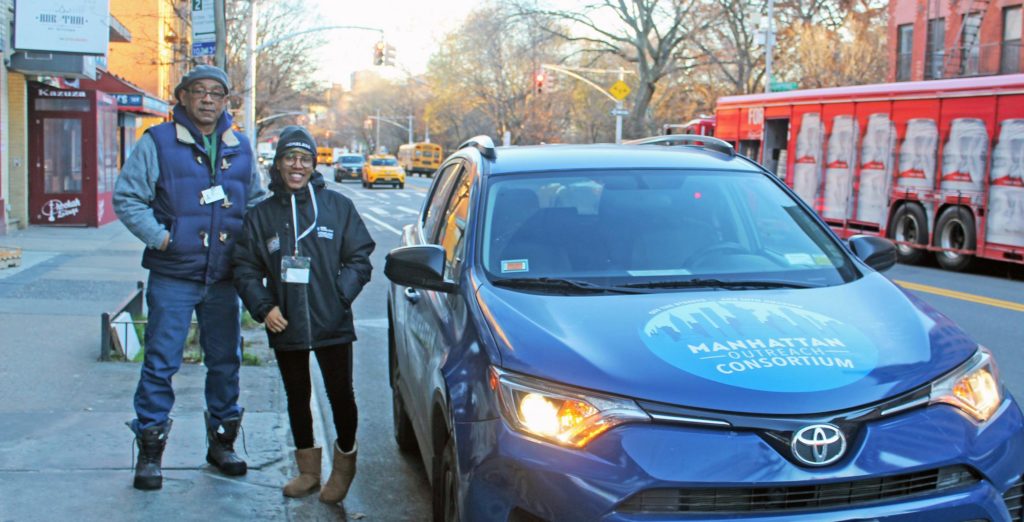
The sky is still black at 5:45 AM when homeless outreach specialists Eugene Lewis and Maribeth Gayle climb into a small SUV parked around the corner from their Chinatown office. With the temperature hovering below freezing, they’re bundled up in hats, boots and heavy jackets. The city has declared a Code Blue, meaning people staying out in the street are in danger from the cold—so Gayle and Lewis are going out to check on their most vulnerable clients.
“There aren’t as many people on the street in the winter,” Gayle explains. “A lot of them go into the subways or hospitals. But the really entrenched people who sleep out in all weather Ð they’re the ones we put on the Code Blue list.”
Our Downtown outreach office covers all of Manhattan south of 23rd Street, where some of Manhattan’s lowest-income neighborhoods lie cheek by jowl with its richest. Gayle and Lewis know where their clients usually hang out. They check familiar places and go to their network of contacts.
“Have you seen Liz lately?” Gayle calls out the window to two security guards. They shake their heads.
“These guys work here and they help us out,” she explains, rolling up the window.
Next we stop at a structure built from scrap lumber and milk crates, neatly covered with a plastic tarp. It’s tucked into a small alley; if you were strolling through the neighborhood you’d never know it was there.
“Are you okay? You got enough blankets and clothes on?” Lewis calls through the tarp. A male voice from inside answers in the affirmative, and they chat for a minute. “All right. Take care,” says Lewis.
“He’s undocumented,” he explains as we walk back to the car. “He doesn’t usually come out when I’m around. But the people here love him and give him food Ð he’s a super nice guy.”
We get back in the SUV and drive on.
By law, the team can’t remove anyone from the streets against their will unless that person’s health or safety is at risk. But they stand ready to bring clients to a shelter, drop-in center or hospital. “We called 911 yesterday for a client who was really cold. He asked us to call,” says Gayle. “He was in distress, he had swollen hands and his face was red.”
During a Code Blue, the city adds more teams and checks on people more frequently. Those checks are designed to keep people safe, but they’re also knit into the larger fabric of interactions that, over time, help them move into permanent housing. There are many barriers that make it hard for people to move off the streets. They may lack ID; they may be struggling with mental illness or substance issues; perhaps they’ve had bad experiences with previous housing or shelters, or they’re reluctant to trust the system.
By visiting clients on a daily basis for months or even years, helping them get paperwork, medical care, SNAP benefits and other things they need, our homeless outreach specialists build trust.
“It’s exciting when someone moves inside, but also when they just accept services and start working with us,” says Downtown Outreach director Jennie Drossman. “There was one client who wouldn’t talk to us at all at first, who really had trouble trusting anyone because of his life experiences. Now he’s in temporary housing and he’s actually interviewing at permanent residences.”
That’s the end game Gayle is angling toward when she chats with a man in a blue puffy jacket on a corner in Tribeca.
“Someone already checked on me last night,” the man points out. His jacket hood, lined with a fuzzy material, is pulled up over his head; you can see his puffs of breath in the winter air.
“That’s what we do, Mr. Johnson,” Gayle says lightly. “We’ll see you later!”
Some names and details have been changed to protect client confidentiality